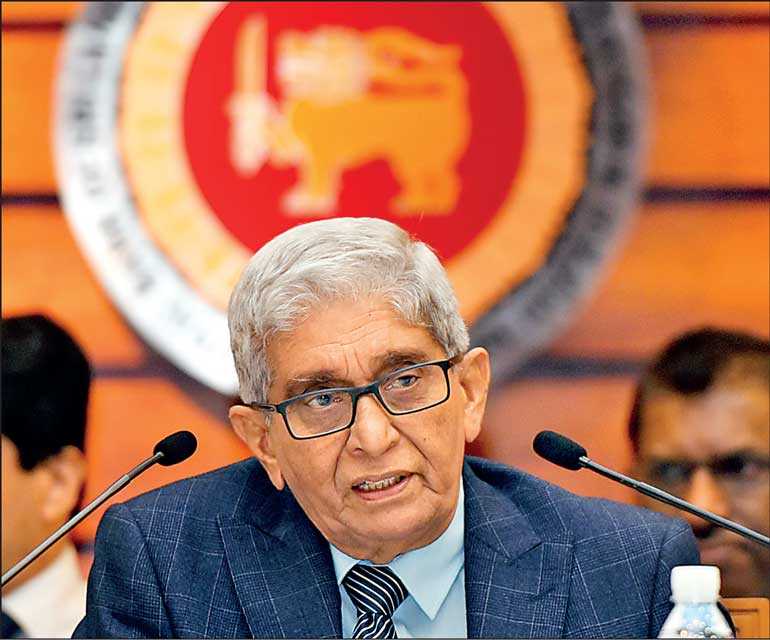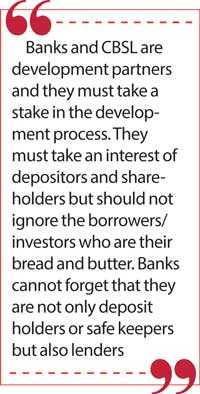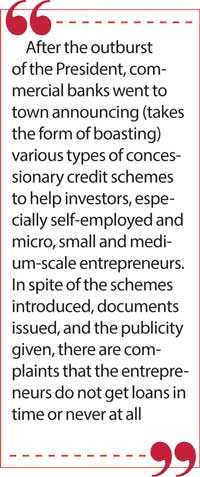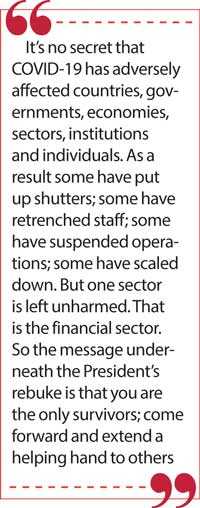Friday Jan 02, 2026
Friday Jan 02, 2026
Wednesday, 15 July 2020 00:00 - - {{hitsCtrl.values.hits}}

By Chandrasena Maliyadde
It was widely reported in all forms of media that an angry President took the senior staff of the Central Bank of Sri Lanka (CBSL) from the Governor downwards to task for slowness and inadequacy of credit flowing to entrepreneurs including Micro, Small and Medium Enterprises (MSMEs).
It’s no secret that CBSL officials worked until dawn to beat the deadline given by the President to come up with a remedy. The next day the CBSL announced its package to ensure availability of additional liquidity. The speed was unprecedented and sent shockwaves through the financial system. There has been both praise and criticism of the package delivered, the speed at which it came out, and the President’s rebuke.
Some say the CBSL officers have not been active enough and needed a shock of this nature to awaken from their slumber in the cold rooms warming comfortable seats in the tower situated in the middle of Colombo Fort. They believe that CBSL should move away from its traditional snail’s pace and support  and contribute to Government programs for recovery from the COVID-19 health crisis. Some say CBSL independence and image should not be harmed; its traditions should be respected; and it must be allowed to take calculated decisions within its purview and according to Monetary Law Act.
and contribute to Government programs for recovery from the COVID-19 health crisis. Some say CBSL independence and image should not be harmed; its traditions should be respected; and it must be allowed to take calculated decisions within its purview and according to Monetary Law Act.
Among the critics there are retired Central Bankers, bankers, bankers’ associations, politicians and economists. Prof. W.D. Lakshman who has been a reputed, renowned and respected economics guru for over a half a century, teaching about the role of the CBSL and the banking system and trying to adjust to his new role as a practitioner of what he has been teaching, must be nonplussed. However, he has well received the message driven home by the President and got his senior economists to burn the midnight oil and announced several packages of monetary relief the next day.
I, being a student of Prof. Lakshman, kept awake myself several days reading the details of packages and the response of supporting and opposing groups reported in the media. Having read divergent views expressed by learned on the role of CBSL, commercial banks and other financial institutions, I thought I would share my experience as an ordinary citizen as well as a retired public servant.
It’s no secret that COVID-19 has adversely affected countries, governments, economies, sectors, institutions and individuals. As a result some have put up shutters; some have retrenched staff; some have suspended operations; some have scaled down. But one sector is left unharmed. That is the financial sector. So the message underneath the President’s rebuke is that you are the only survivors; come forward and extend a helping hand to others.
Some are critical of the tone, time, venue, and publicity, plus the independence and image, but none can say the message is wrong. And the message had been well received. CBSL, for its existence of 70 years, delivered the fastest package of financial assistance within less than 12 hours. CBSL pumped an additional Rs. 150 billion liquidity at an interest rate of 4% in an unprecedented speed.
CBSL duties
I came across a reprint of Monetary Law Act incorporating all amendments made up to 30 June, 2014 issued by CBSL. According to this document, CBSL is charged with the duty of securing the following objectives, namely–
(a) economic and price stability; and (b) financial system stability, with a view to encouraging and promoting the development of the productive resources of Sri Lanka. Objectives are not ends by themselves but a means to an end. Unfortunately, most of the critiques have seen the means in larger prints but, missed the end in illegible prints.
Prableen Bajpai in her article ‘How Central Banks Control the Supply of Money’ says: If a nations economy were a human body, then its heart would be the central bank. And just as the heart works to pump life-giving blood throughout the body, the central bank pumps money into the economy to keep it healthy and growing.
Monetary policy is the process by which a central bank manages the supply and the cost of money in an economy mainly with a view to achieve the macroeconomic objective of price stability. CBSL is responsible for conducting monetary policy, which mainly involves setting the policy interest rates and managing the liquidity in the economy. The monetary operations of the Central Bank influence interest rates in the economy, affecting the behaviour of borrowers and lenders, economic activity and ultimately the rate of inflation. Therefore, the Central Bank uses monetary policy to control inflation and keep it within a desired path.
As part of its mandate of financial system stability, the CBSL undertakes surveillance and oversight of the entire financial system taking into account its interaction with the real economy to monitor and limit systemic risks which could lead to financial and economic crises.
The financial system
The CBSL is responsible for regulating and supervising banks and selected non-bank financial institutions to promote their soundness and to safeguard the interests of depositors and investors.
As students of Economics in the shade of Prof. Lakshman 50 years back, we learned of currency issued by the Central Bank and money created by commercial banks as components of the money supply. But, today when Prof. Lakshman is at the helm of financial system, we hear about digital money, M cash, mobile transfers, credit cards, debit cards, ATM, black money, money laundering and cashless transactions. And in addition to banks, we hear about Non-Bank Financial Institutions such as Licensed Finance Companies, Specialised Leasing Companies and Licensed Microfinance Companies. 
Further, in addition to the Monetary Law Act, we come across the Banking Act, Finance Business Act, the Finance Leasing Act and Microfinance Act, Local Treasury Bills Ordinance and the Registered Stocks and Securities Ordinance. The financial system is complex with multitudinous actors, multitudinous transactions and multitudinous acts. These are in addition to changes taken place globally such as exploding information system, migrated worker remittances, supply chain changes, dominance of services over goods in export baskets, foreign aid, foreign investment which were alien to us as students in the University.
In such a rapidly-changing scenario, one would wonder whether CBSL and its defenders can continue to shield behind the Monetary Law Act introduced 70 years back and jargon such as independence, image, etc.
Commercial banks
After the outburst of the President, commercial banks went to town announcing (takes the form of boasting) various types of concessionary credit schemes to help investors, especially self-employed and micro, small and medium-scale entrepreneurs. In spite of the schemes introduced, documents issued, and the publicity given, there are complaints that the entrepreneurs do not get loans in time or never at all. This is attributed to lengthy cumbersome documentation (because some enjoy digging into details irrelevant to the purpose), absence of collateral acceptable to the bank, delays in approval (Christmas tree arrives after Christmas) and varying other reasons.
There are many investors including my son who have approached me to put in a word to get the loan approval expedited. Bankers’ argument is that they are responsible to depositors and shareholders and no way can they take a risk. Have I heard wrong that a financial institution (banks included) is a company engaged in the business of dealing with financial and monetary transactions such as deposits, loans and investments?
In my opinion commercial banks are financial enterprises. An entrepreneur is an individual who creates a new business, bearing most of the risks and enjoying the rewards. If banks are unable to take a risk they are not fit to be an entrepreneur. Commercial banks unlike other entrepreneurs are the only category that has a lender of last resort.
As one paper article mentioned, Sri Lankan banks do not provide project lending. Whatever the type, they go for collateral-based lending. Banks would seek cover in stating that they do not have capacity to assess the viability of a project. If they do not have the capacity it is not the fault of the customer. It is the responsibility of the management.
On the one hand, Sri Lankan banks have not been able to attune to the changing credit climate over the years. On the other, banks would cater to demand as long as the recovery is guaranteed irrespective of the importance and relevance of the project/purpose to the national economy. CBSL has been happily nodding its head to this attitude.
Either both CBSL and the commercial banks have been interested in the health and the welfare of the banking system or they were not sensitive to the development needs of the nation. There are measures available to promote project lending.
Fifty years ago as a student of economics, I experienced echoing of Prof. Lakshman’s voice on interest rate structure. Rather than having one single interest rate common to any type of credit, CBSL can  introduce a discriminatory interest rate structure to promote/demote credit to certain sectors. CBSL can also help commercial banks to improve the capacity and facilities for project viability based lending. We have a demand pull credit culture. CBSL and banks can promote a supply push credit culture. Banks are waiting with a bag of money for people to come with requests for credit.
introduce a discriminatory interest rate structure to promote/demote credit to certain sectors. CBSL can also help commercial banks to improve the capacity and facilities for project viability based lending. We have a demand pull credit culture. CBSL and banks can promote a supply push credit culture. Banks are waiting with a bag of money for people to come with requests for credit.
Banks blame entrepreneurs for misusing funds. A chairman of a leading commercial bank writes ‘From bank to the pocket or to the business?’ We can ask the same question from commercial banks. A writer, in an article recently stated: “Sri Lanka’s commercial banks are at present in a state of a massive excess liquidity. They are sitting on a huge amount of cash but there are no matching loan applications to dispose it. They have been parking their excess cash in an interest earning deposit with the Central Bank under its Standing Deposit Facility.” If this is not misusing what do we call it? The pot calling the kettle black.
Loan applications
My son says even if he goes with a project, the bank takes a long time to accommodate his request. This is due to documentation, approval process and absence of collateral. The bank manager is the best to know about the area, potential projects, banking habits and the borrowers. He is the most competent man in the system to assess and proceed with a loan application. He also takes the responsibility for his recommendation of an application. But he is unable to take a decision. The application with his recommendation passes through several steps and reaches the table in the Head Office, CB, Treasury or Ministry.
The decision is taken at that end and flowing down to the bank manager through the same multi-level hierarchical channel. The borrower has to wait a minimum of three months having his fingers crossed to hear the fate of his application. If it is not denied it is already too late. In the case of an agriculture project, the cultivation season is over; input suppliers are gone; market is lost; the applicant is indebted to his relatives and friends if he has not lost them already.
The CBSL move to providing more liquidity can satisfy statisticians and politicians but not the market. Has the thought that the lengthy cumbersome approval process leads to mushrooming financial companies and existence of money lenders come up? CBSL and banks can think of delegating the authority for approving loans at least initially for SMEs to respective branch managers.
Success or failure or profits and losses of an enterprise are not measured by looking at each and every transaction. It is the yearend balance sheet. Some products, transactions, items will bring profits while some would fail. But commercial banks unlike other enterprises are trying to make profits from each and every transaction. They chase after every borrower to ensure no bad credits. This is unrealistic in the business world. It is natural and unavoidable that some business would fail. This does not mean that the banks can be lackadaisical. They must try to avoid failures but be ready to accept failures. What matters is not avoiding any failure and recovering every loan disbursed and making profits. Some loans will fail. Some succeed. At the end total should be positive.
Banks and CBSL are development partners and they must take a stake in the development process. They must take an interest of depositors and shareholders but should not ignore the borrowers/investors who are their bread and butter. Banks cannot forget that they are not only deposit holders or safe keepers but also lenders.
Personal experience
Let me end up recalling an incident I experienced as a child. My father wanted to buy a cow to supplement the nutrition intake of his two sons and his meagre daily earnings. He approached the village money lender. No documentation, no hassle, no delay. Loan was negotiated; interest was 10% per month; crumpled deed was collateral.
Next day, when we returned home after school, we encountered a stranger, the cow. Mother was so busy in feeding and running behind it. Mother could not really spare a minute from us. There was no grazing land; meagre earnings could not permit buying fodder. The cow was neglected, fell sick and died a few weeks later.
Our next door neighbour dearly called “Nenda” (aunt) and her husband “maama” (uncle) blindly followed my father and bought a cow. Only difference was they borrowed from the bank. Collateral was again their tiny land; interest was 10% for the whole year; the delay, documentation, and hassle was only 10 times of what my father experienced. They had the same experience. Cow did not survive long. My father faced difficulties in paying the monthly interest while our neighbour had to pay both loan instalments and the interest. Only option was pawning some glittery items known as jewellery.
Why did I share a bit of my experience in my private life? Just to compare the plight of our poor faced with money lenders and the banks/finance companies. Is a bank different from the village money lender? Apart from the interest rate charged and the attire, the difference is noted is in time taken, heap of documentation, and the interest/indifference of the lender.
We are blessed to be students of Prof. Lakshman. Economic students produced during the past half-a-century period by Prof. Lakshman are waiting to see how he is going to translate his learning, his teaching, his exposure and his experience into action and create a new banking culture in this country.
We saw that CBSL has inserted a few paper advertisements explaining its role (rather its inability and limits) towards Non-Banking Financial Institutions and what it has been doing during the last several months to ease the financial difficulties of entrepreneurs. After all, the taste of the pudding is in the eating.
We wish good luck to our beloved guru!
(The writer has served as a secretary to three ministries before his retirement. He is currently a Vice President of the Sri Lanka Economic Association. He can be reached via [email protected].)